
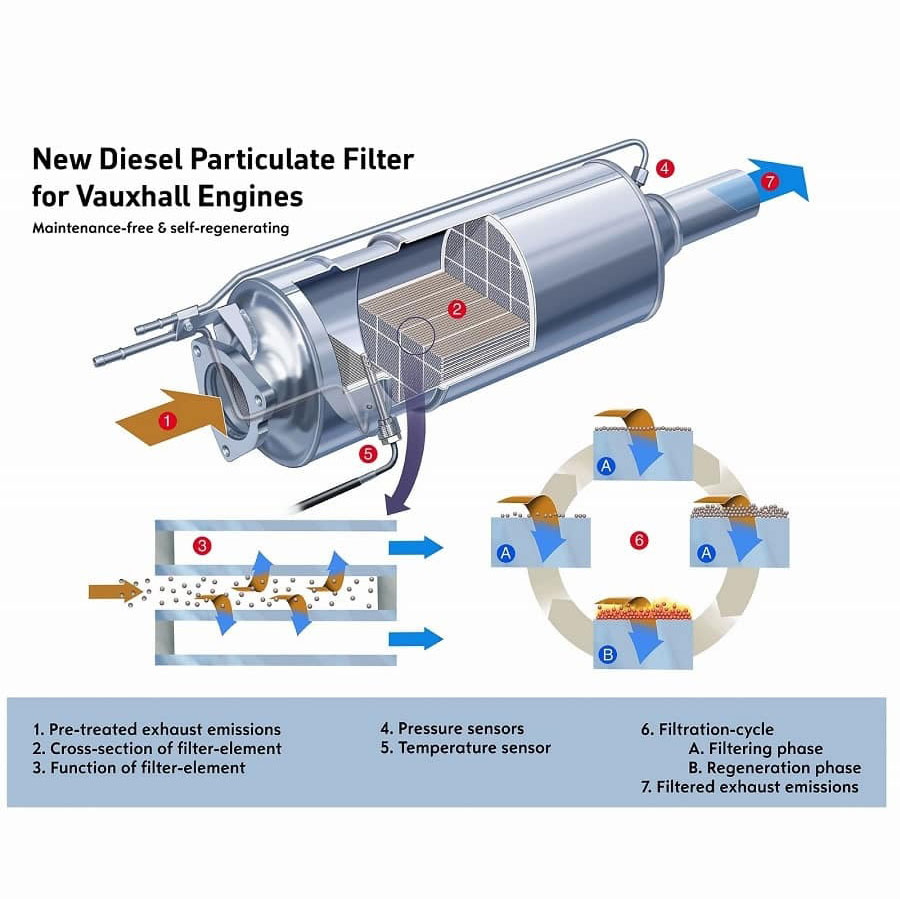
The Diesel Particulate Filter (DPF) is an essential component designed to reduce harmful emissions by trapping soot and particulate matter, ensuring a cleaner exhaust. Understanding its function and maintenance is crucial for optimal engine performance and longevity, which AutoExplain.com can help you achieve. Regular maintenance and timely repairs are essential to keep your DPF functioning efficiently, and our experts at AutoExplain.com offer remote support for diagnosis, programming, and software installation to address any DPF-related issues.
Table of Contents
ToggleA DPF, or Diesel Particulate Filter, is a vital component in diesel vehicles designed to trap particulate matter such as soot and ash. Diesel Particulate Filters (DPFs) are aftertreatment devices that significantly reduce emissions from diesel engines by capturing and storing exhaust soot, which undergoes periodic burning for filter regeneration. This process prevents harmful exhaust emissions and the characteristic black smoke often seen during acceleration in older diesel vehicles.
Engine manufacturers implement DPFs to effectively trap particulate matter, meeting the stringent EPA 2007 emission standards and ensuring cleaner air quality. According to research from the United States Environmental Protection Agency (EPA), the implementation of DPFs has led to a 90% reduction in diesel particulate matter emissions since 2007, significantly improving air quality in urban areas.
A DPF system typically includes the diesel particulate filter itself, along with sensors that monitor pressure and temperature. DPF systems are crucial for reducing emissions from diesel vehicles by trapping soot and ash. The DPF is generally made from ceramic materials like cordierite or silicon carbide. Regular maintenance and regeneration are essential for keeping the filter in good working order.
The DPF system captures and removes soot and particulate matter from diesel engine exhaust. As exhaust gases pass through the filter, fine particles are trapped in the porous walls, preventing their release into the atmosphere. According to a study by the University of California, Riverside’s College of Engineering, DPFs can trap up to 85% of particulate matter from diesel exhaust, significantly reducing air pollution. Over time, the filter undergoes regeneration, where high temperatures burn off accumulated soot, converting it into ash and maintaining efficient function.
Regular maintenance and proper operation are essential to prevent clogging and ensure optimal engine performance. AutoExplain.com offers remote support to diagnose and address any issues, ensuring your DPF system operates efficiently.

At first glance, a Diesel Particulate Filter (DPF) might look like a simple metal canister in the exhaust system — but inside, it’s a carefully engineered structure designed to trap and store harmful soot particles. Understanding what’s inside a DPF filter gives you insight into how it works and why maintenance is so important.

The heart of the DPF is the ceramic substrate, usually made from cordierite or silicon carbide. This material is chosen for its ability to withstand extremely high temperatures without degrading. The substrate has a honeycomb structure with thousands of tiny channels or cells.
These channels are alternately plugged at opposite ends.
This plug configuration forces the exhaust gas to flow through the porous walls of the ceramic channels.
As the gases pass through, soot particles are trapped in the walls, while clean gases continue to flow out the tailpipe.
2. Wall-Flow Filtration Technology
DPFs use what’s called wall-flow technology. Instead of gases flowing straight through, they’re forced to pass through the cell walls of the ceramic material.
The walls are microporous, allowing gas molecules to pass through while capturing solid particles.
Over time, this trapped soot builds up and needs to be burned off through regeneration.
This filtration process is highly efficient — typically capturing over 90% of diesel particulate matter.
3. Catalyst Coating (Optional in Some DPFs)
Some DPFs are coated with a catalyst layer, similar to those used in catalytic converters. This type is known as a catalyzed DPF (CDPF).
The catalyst coating (usually platinum or palladium) helps lower the temperature needed for regeneration.
It assists in oxidizing soot into carbon dioxide even at lower exhaust temperatures.
Catalyzed DPFs can sometimes passively regenerate during normal driving, making them more efficient in certain conditions.
4. Pressure and Temperature Sensors
While not physically “inside” the filter core itself, sensors are mounted in or around the DPF to monitor:
Back pressure (to detect clogging or soot buildup)
Temperature (to determine if regeneration conditions are met)
These sensors provide real-time data to the Engine Control Unit (ECU), which controls the regeneration process and triggers warning lights when needed.
5. Insulation and Outer Shell
Surrounding the ceramic core is a layer of thermal insulation to retain heat and protect the filter from external elements. All of this is enclosed in a stainless steel shell, which provides durability and protection against corrosion, vibration, and road conditions.
The key to maintaining a DPF is to ensure regeneration is possible when it fills with soot, which typically triggers a warning light. Maintaining a DPF requires ensuring that regeneration, the process of burning off accumulated soot, occurs regularly to prevent clogging and maintain optimal function. The two main types of regeneration are passive and active.
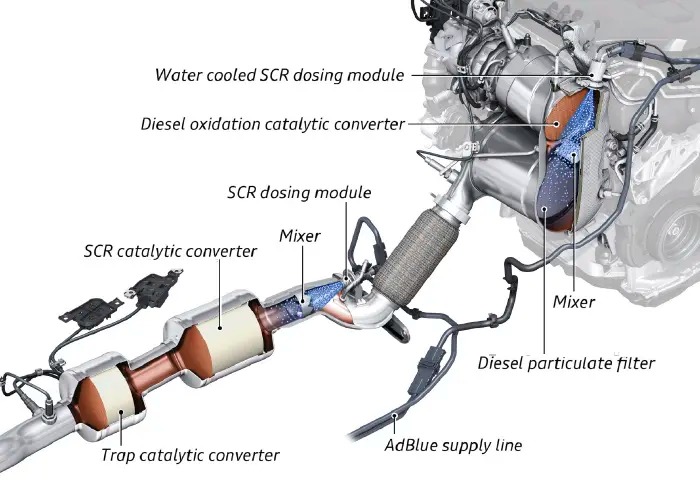
Passive regeneration occurs automatically during normal vehicle operation when exhaust temperatures are high enough to burn off accumulated soot. Passive regeneration occurs when the engine heat builds to the point where soot, or carbon, combines with oxygen to create carbon dioxide, a gas that can pass through the filter. Ash, a byproduct of combustion, cannot be converted by engine heat and will eventually require filter removal and cleaning. This process typically happens when driving at highway speeds for an extended period.
Passive regeneration occurs as the vehicle is driven normally under load, without any driver intervention. It may not always keep the DPF clean, potentially necessitating active regeneration.
Active regeneration is initiated by the engine control unit (ECU) when it detects that the soot level in the DPF has reached a certain threshold. Active regeneration is part of normal engine operation, but it requires the engine to take specific actions. For example, a truck fully loaded on the highway generates enough heat for passive regeneration. Active regeneration takes place when the engine isn’t creating enough heat. Fuel is injected into the exhaust stream, oxidizing over the diesel oxidation catalyst (DOC) to create heat, which converts soot to carbon dioxide.
According to a study by the Oak Ridge National Laboratory, active regeneration can increase fuel consumption by 5-10% during the regeneration process. Both active and passive regeneration happen automatically, without driver input, though active regeneration can occur anytime the vehicle is moving. Exhaust gas temperatures can reach up to 1,500°F (800°C). Drivers may notice a “high-exhaust temp” light when the aftertreatment doser starts injecting fuel, increasing the temperature in the aftertreatment device.
When active or passive regeneration fails, a parked regeneration may be necessary. A parked regeneration is an operator-activated process that requires the vehicle to be stationary. The driver or technician brings the engine to operating temperature and initiates the parked regeneration via dash controls. This process can take 20 minutes to an hour, depending on ambient conditions, engine type, and DPF system.
Before initiating, ensure exhaust outlets are directed away from structures, vegetation, flammable materials, and anything susceptible to high heat damage. Not all DPF systems have a parked regeneration feature. If you need assistance with this process, contact AutoExplain.com for expert guidance.
1. Frequent Short Trips or City Driving
One of the most frequent causes of DPF blockages is driving patterns that don’t support regeneration. Regeneration requires sustained engine temperatures (typically over 500°C/932°F), which are hard to reach during short city commutes or stop-start traffic.
Why it matters: The engine doesn’t get hot enough or run long enough for soot to burn off.
Result: Soot builds up quickly, and passive or even active regeneration fails, leading to a clogged DPF.
Tip: Take the vehicle on longer drives at higher speeds (highway runs) periodically to allow full regeneration cycles to complete.
2. Failed or Incomplete Regeneration
Regeneration is the DPF’s self-cleaning process, but if it’s interrupted or doesn’t start properly, soot will accumulate.
Passive regeneration happens automatically during long drives.
Active regeneration is triggered by the ECU using extra fuel to raise exhaust temperatures.
Common reasons regeneration fails:
Stopping the engine mid-regeneration
Low fuel level (many systems won’t regen below ¼ tank)
Faulty sensors (temperature, pressure, etc.)
Software or ECU errors
3. Faulty Exhaust or DPF Sensors
Modern DPF systems rely on several sensors to function properly. If one of these fails, it can cause regeneration to be delayed or skipped entirely.
Key sensors include:
DPF pressure sensor – Monitors soot load
Exhaust temperature sensors – Ensure correct conditions for regen
NOx or O2 sensors – Help control emissions and feedback to ECU
Sensor failure = incorrect data → regeneration doesn’t start or stops too early.
4. Incorrect Engine Oil
Using the wrong engine oil can significantly increase ash buildup inside the DPF. While soot can be burned off during regeneration, ash from oil additives cannot.
Low-SAPS (Sulfated Ash, Phosphorus, Sulfur) oils are specifically formulated for DPF-equipped vehicles.
Using regular oil can reduce DPF lifespan and cause premature clogging.
Always check your owner’s manual or look for oil labeled DPF-safe or ACEA C1–C4.
5. EGR System Malfunction
The Exhaust Gas Recirculation (EGR) system helps reduce NOx emissions by recirculating a portion of the exhaust gas back into the engine. But if it malfunctions or becomes clogged, it can result in increased soot production.
More soot = faster DPF blockage.
Common in older or high-mileage diesel engines.
Symptoms of a faulty EGR include poor performance, excessive smoke, and rough idle — all of which can contribute to a clogged DPF.
6. Turbocharger Issues
A failing or leaking turbocharger can increase oil consumption, sending oil particles into the exhaust system. These can contaminate the DPF and prevent proper regeneration.
Oil in the exhaust can cause sticky soot that’s harder to burn off.
Over time, this can lead to irreversible damage to the DPF core.
7. Poor Fuel Quality
Low-quality diesel or fuel contaminated with water and debris can cause incomplete combustion, leading to higher soot output. Some cheap fuels may also contain higher sulfur content, which accelerates ash buildup in the DPF.
Tip: Stick to trusted fuel brands and avoid refueling from questionable sources.
8. Driving With Low Fuel Levels
Some diesel vehicles are programmed not to begin active regeneration if the fuel tank is too low, typically under ¼. This is a built-in safety feature to prevent running out of fuel during regen, but it can lead to missed regeneration opportunities.
Frequent low-fuel driving = delayed regen = soot accumulation.
9. Software or ECU Problems
Occasionally, DPF issues are the result of a software bug or miscommunication between the ECU and sensors. This can prevent proper tracking of soot levels or prevent regeneration commands from being executed.
A simple ECU reset or software update may solve the issue.
In some cases, a faulty ECU needs to be replaced or reprogrammed.
10. Mechanical Failures or Cracks in the DPF
In rare cases, the DPF unit itself can suffer from physical damage — such as cracks in the ceramic core or thermal stress fractures.
This may allow soot to bypass the filtration system or cause uneven regeneration.
Damaged DPFs often need to be replaced, as repairs are not always effective.
=> You may also like: What causes a DPF filter to clog
=> Related content: Mercedes Benz DPF Fault Code List?
The Diesel Particulate Filter (DPF) plays a vital role in keeping diesel emissions clean, but like any component, it can experience issues over time — especially if not maintained properly or if the vehicle’s driving patterns do not allow for regular regeneration. When the DPF begins to fail or gets clogged, your vehicle will start showing specific symptoms. Recognizing these early warning signs can help prevent expensive repairs and ensure that your engine remains efficient and compliant with emissions regulations.
Below are the most common signs of DPF problems, along with explanations of what each might mean:
The most direct sign of a problem is the DPF warning light on your dashboard. Most modern diesel vehicles are equipped with a sensor that monitors back pressure in the exhaust system. When the DPF becomes clogged and the pressure exceeds safe levels, the ECU triggers a warning light to alert the driver.
What to do: Don’t ignore the light. Try taking the vehicle on a 20–30 minute highway drive to allow for passive regeneration. If the light persists, it may require a diagnostic scan or forced regeneration at a workshop.
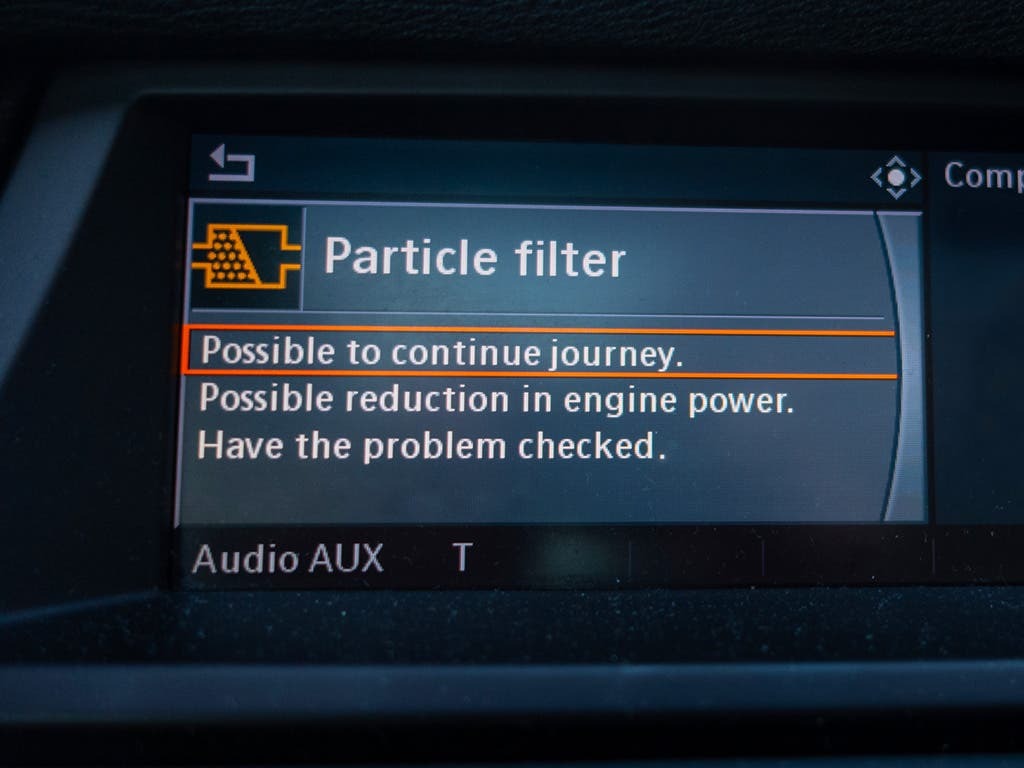
A clogged DPF restricts exhaust gas flow, creating backpressure that impacts overall engine performance. One of the most noticeable symptoms is reduced engine power, particularly under acceleration or at higher speeds.
Why it happens: The engine has to work harder to push exhaust gases through the blocked filter, which reduces efficiency and power output. This can feel like the vehicle is lagging or sluggish when you step on the accelerator.
When the DPF is severely blocked and regeneration has failed, many vehicles will enter limp mode as a protective measure. In limp mode, the engine’s performance is limited to reduce further damage.
What it feels like: Drastically reduced speed, poor throttle response, and a rev limit are all common. You’ll usually only be able to drive at very low speeds, just enough to get to a garage.
Action required: At this stage, a professional mechanic or technician will likely need to perform a forced regeneration using diagnostic equipment. In extreme cases, the DPF may need to be cleaned professionally or replaced.
If your DPF is partially blocked and regeneration cycles are occurring more frequently than normal, you may notice a drop in fuel economy.
Why it happens: During active regeneration, the ECU injects extra fuel to raise the exhaust temperature, which burns off soot in the DPF. This process temporarily increases fuel consumption. If the DPF is constantly regenerating, that increase becomes permanent.
Additional sign: You may also smell excess fuel in the exhaust due to unburned diesel, especially during frequent regen cycles.
Modern diesel vehicles are designed to perform regeneration periodically to burn off soot. However, if you notice your vehicle regenerates more often than usual, it’s a sign the DPF is filling up quicker than it should.
Possible causes:
Frequent short trips that don’t allow regen to complete.
Faulty sensors (like the exhaust temperature or pressure sensor).
Use of incorrect engine oil.
Leaks in the intake or EGR system increasing soot production.
What to do: Pay attention to any abnormal behavior, such as the engine fan running more often, temporary power dips, or a strange smell from the exhaust — all indicators of ongoing regeneration.
While modern diesels should emit minimal visible smoke, a blocked or malfunctioning DPF may cause noticeable smoke from the tailpipe, especially if the filter is cracked or damaged.
What to look for: Excessive white or black smoke during start-up, acceleration, or idling. You might also detect a strong smell of diesel from the exhaust.
Possible causes: A cracked DPF may no longer trap particulates, while unburned fuel from failed regenerations can escape through the exhaust system.
If your engine is idling roughly, feels like it’s misfiring, or even stalls unexpectedly, the DPF might be to blame.
Why it happens: Excess backpressure from a blocked DPF can disrupt the engine’s air-fuel ratio and exhaust flow, leading to unstable idle and stalling.
Warning: These symptoms are often mistaken for injector or fuel pump issues, so it’s important to run a full diagnostic check to pinpoint the DPF as the root cause.
This is a more advanced symptom and can be serious. When a DPF regeneration fails repeatedly, unburned fuel may seep past the piston rings and into the engine oil, causing the oil level to rise and diluting it with diesel.
Risks: This can drastically reduce oil lubrication properties, leading to premature engine wear or even catastrophic engine failure if left unchecked.
What to check: Regularly monitor oil levels and check for diesel odor when changing or inspecting your oil.
Replacing a diesel particulate filter can be pricey, with new filters from car manufacturers costing anywhere from $3,000 to $10,000. The cost of replacing a DPF can range from $3,000 to $10,000, depending on the vehicle manufacturer. However, the cost can vary based on the vehicle’s make and model.
It’s no secret that as cars and trucks age, their value decreases. Often, the price associated with replacing a DPF in an older, higher-mileage car or truck is more than the value of the vehicle itself. It’s much easier and more affordable to clean a diesel particulate filter than it is to replace it, which is why understanding how these filters work and performing regular diesel maintenance is so important. Regular maintenance and timely cleaning can extend the life of your DPF, preventing the need for costly replacements.
If a parts supplier charges less for a DPF, be wary—the filter must be the correct type for your vehicle. Otherwise, you will most likely end up spending more on repairs. Always ensure you are getting the correct DPF for your vehicle to avoid additional repair costs.
Here are some frequently asked questions about diesel particulate filters:
6.1. What is a DPF delete?
A DPF delete involves physically removing the DPF from the exhaust system and reprogramming the ECU to ignore its absence. While it may improve performance and fuel economy, it is illegal in many regions due to environmental regulations. According to the Clean Air Act, tampering with or removing emissions control devices is a federal offense.
6.2. How often should I replace my DPF?
The lifespan of a DPF varies depending on usage and maintenance but typically ranges from 80,000 to 150,000 miles. Regular maintenance and proper driving habits can extend its life.
6.3. Can I clean my DPF myself?
While some DIY cleaning methods exist, it’s generally recommended to have a professional clean your DPF to ensure it’s done correctly and without causing damage. Professional cleaning services use specialized equipment to remove accumulated ash and soot effectively.
6.4. What type of engine oil should I use for a diesel engine with a DPF?
Use low-ash engine oil that meets the manufacturer’s specifications. These oils are designed to produce less ash, reducing the risk of DPF clogging. Always refer to your vehicle’s manual for the recommended oil type.
6.5. How does driving style affect DPF performance?
Aggressive driving and frequent short trips can increase soot production and accelerate DPF clogging. Smooth, consistent driving at higher speeds allows for passive regeneration, helping to keep the DPF clean.
6.6. What is the role of the differential pressure sensor in the DPF system?
The differential pressure sensor measures the pressure difference between the inlet and outlet sides of the DPF. This data is used to determine the level of soot accumulation and trigger regeneration when necessary. A malfunctioning sensor can lead to incorrect regeneration cycles and DPF issues.
6.7. Can performance modifications affect the DPF?
Yes, performance modifications that increase engine output can also increase soot production, leading to faster DPF clogging. It’s important to ensure that any modifications are compatible with the DPF system and do not compromise its functionality.
6.8. What is the difference between a DPF and a catalytic converter?
A DPF traps particulate matter (soot and ash), while a catalytic converter reduces harmful gases like nitrogen oxides (NOx), carbon monoxide (CO), and hydrocarbons (HC). Both are important components in reducing emissions from diesel engines but serve different functions.
6.9. How do I know if active regeneration is occurring?
During active regeneration, you may notice increased fuel consumption, a change in engine sound, or a hot smell from the exhaust. Some vehicles also have an indicator light that illuminates during regeneration.
6.10. What should I do if the DPF warning light comes on?
If the DPF warning light illuminates, try driving at a steady speed on the highway for 20-30 minutes to allow for passive regeneration. If the light persists, consult a professional technician for further diagnosis and possible active regeneration or cleaning. If you are still unsure of what to do, do not hesitate to contact AutoExplain.com.
6.11. How Do Short Journeys at Low Speeds Affect DPF?
Short journeys at low speeds prevent the vehicle from reaching the necessary exhaust temperatures for passive regeneration to occur. When vehicles operate at low speeds for short durations, the exhaust system does not get hot enough to burn off the accumulated soot. This leads to a gradual buildup of particulate matter, eventually clogging the DPF and reducing engine performance.
6.12. How Does Poor Servicing Impact DPF?
DPFs can fail due to poor servicing. The lifespan of a diesel particulate filter varies based on the application. The Cummins ISX15 engine’s filter, for example, has a cleaning interval of 400,000 to 600,000 miles but will need to regenerate before hitting the 400,000-mile mark. Regular maintenance, including filter inspections and timely replacements when necessary, is crucial for maintaining its efficiency. Neglecting these services can lead to premature failure and costly repairs.
6.13. What Happens If There is Lack of Maintenance on DPF?
DPFs may fail sooner if they are not well maintained. Additionally, filter blockage can result from using the wrong type of oil, performance modifications, low-quality fuel, or frequently running the vehicle on a low fuel level. Proper maintenance involves using the correct engine oil and fuel, as well as adhering to the manufacturer’s recommended service intervals.
6.14. Can The Wrong Type of Oil or Fuel Damage DPF?
Using the wrong oil or fuel can contribute to DPF blockages and failures. Low-quality fuel or high-ash engine oil can produce excessive soot and residue, leading to faster filter clogging. To prevent issues, always use manufacturer-recommended low-ash engine oil and ultra-low sulfur diesel (ULSD) to ensure cleaner combustion and reduce particulate buildup in the DPF. According to a study by the Southwest Research Institute, using high-sulfur fuel can reduce DPF lifespan by up to 50%.
AutoExplain.com offers comprehensive remote support for diagnosing and resolving DPF-related issues. Our team of expert technicians provides assistance with error code analysis, troubleshooting, and software updates to ensure your DPF system operates efficiently. With our remote services, you can receive quick and effective support without the need for costly on-site visits.
Facing DPF problems? Don’t let them slow you down. Contact AutoExplain.com today via WhatsApp at +1(936)2896695 or email at [email protected] for expert technical support. Our team is ready to assist with all your diagnostic, programming, and software installation needs. You can also visit our office at 1500 N Grant ST Sten Denver, CO 80203. Let AutoExplain.com keep your diesel engine running smoothly.
=> Related content:



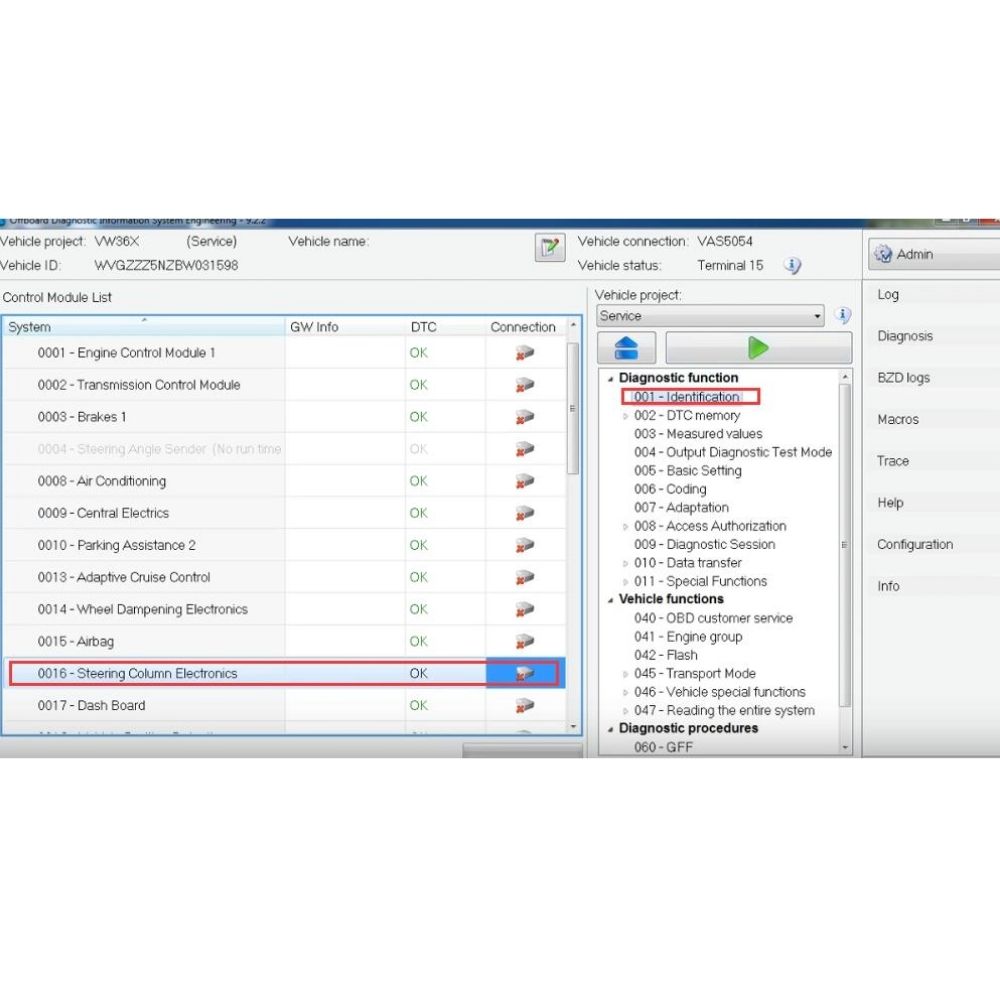



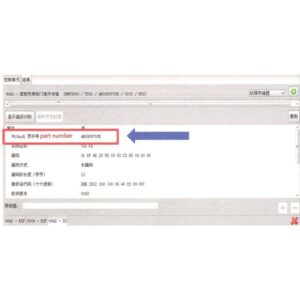
At AutoExplain, we provide automotive online repair service, auto repair tips, car repair manuals & document & training course to help mechanics of all experience levels—fix vehicles efficiently
AUTO EXPLAIN LLC
Employer Identification Number (EIN):
38-4349958
Whatsapp Us: +1(936)2896695
Gmail: [email protected]
Our Workshop: 1500 N Grant ST Sten Denver, Colorado, United States
Copyright 2025 © AutoExplain